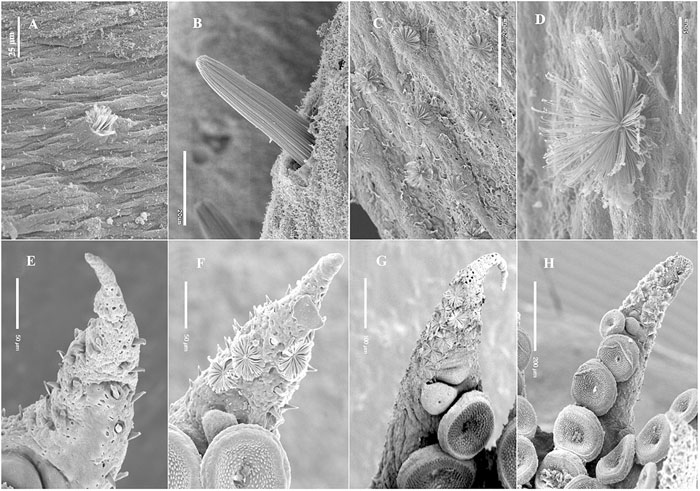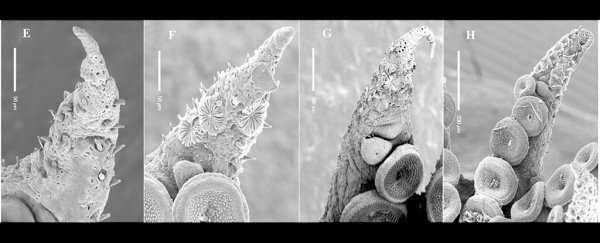Your internal organs grow and change throughout your life, but rarely do they vanish without a trace. For baby octopuses, things are not so simple.
Before they are born, embryonic octopuses sprout hundreds of temporary, microscopic structures known as Kölliker's organs (KO).
These tiny organs cover every surface of the octopus's body, sometimes hiding inside little pockets in the skin, and sometimes extending (or "everting") like tiny folded-up umbrellas.
Once everted, each organ may bloom open, revealing a burst of bristly fibers.
"When partially everted, KO look like a broom," Roger Villanueva, a researcher with the Institut de Ciències del Mar at the Spanish National Research Council (CSIC), told Live Science in an email. "When totally everted, KO looks like half of a dandelion flower."
Related: 8 crazy facts about octopuses
Close-up with the KO
Biologists have known about these microscopic flowering organs for decades – but none could say for sure what they are for, or why embryonic octopuses completely lose their array of bristly bits and bobs long before reaching adulthood.
Now, recent research by Villanueva and his colleagues helps to shed light on the mysterious disappearing organs.
In a study published in the May 2021 issue of the journal Frontiers in Marine Science, the researchers examined 17 species of embryonic octopuses using a technique called light-sheet microscopy – essentially, a way of immersing a sample in fluid to make that sample transparent, then shining light through it to highlight hard-to-see structures.
Of the 17 species studied, 15 had KO; the two that didn't were both holobenthic octopuses, meaning they are born relatively large and spend their entire lives in the deep ocean.
Almost all of the 15 species that did have KO are born planktonic – meaning hatchlings are born very small and swim higher in the water column while their bodies grow and morph into adulthood.
 (Villanueva et al., Frontiers in Marine Science, 2021)
(Villanueva et al., Frontiers in Marine Science, 2021)
Above: These images show the eruption and eversion sequence of Kölliker's organs on several different young male octopuses on different days.
The team learned that KO are dispersed evenly across the bodies of young octopuses, and they tend to be the same size, regardless of the size of the embryo.
They also discovered that, when all of an octopus's KO are fully spread open, the animal's surface area increases by a whopping two-thirds.
These discoveries could hint at the mysterious purpose of KO, the researchers said.
"[We] think that the organs could be used by the young octopuses to increase their surface-to-volume ratio," Villanueva, who is the study's lead author, said in a statement.
With the ability to significantly increase or decrease their surface area, young octopuses may be better equipped to propel themselves through ocean currents, or to resist them – a particularly useful trait for planktonic hatchlings, which spend their early lives moving at the whims of those currents.
Deploying or retracting their KO could help the hatchlings conserve energy, the researchers hypothesized.
But there's another, sneakier possibility. The researchers point to a 1974 study in the journal Aquaculture, which showed that, like crystals, KO can refract light in multiple directions. This refractive ability could help smear the hatchling's outline in the water, making them harder for predators to catch, the researchers said.
If KO play a role in camouflage, that could explain why many octopuses that dwell near the deep, dark ocean floor don't grow KO at all; in the lightless depths, there's no need for camouflage.
It's a possibility, anyway; even after looking closer at the structure of KO than any study before, the researchers say the true purpose of the unusual, disappearing organs remains a mystery.
Future observations of hatchling octopuses in the wild could help biologists come closer to an explanation. For now, the researchers are happy just to share the strange beauty of little cephalopods like they've never been seen before.
"To explore inside the tissues and organs of hatchlings and juvenile octopuses at cellular resolution has been fascinating," study co-author Montserrat Coll-Llado, a mesoscopic imaging specialist at the European Molecular Biology Laboratory, Barcelona, told Live Science. "It's been like exploring the little corners of a city where you've never been – but better."
Related content:
Photos: Deep-sea expedition discovers metropolis of octopuses
In photos: Amazing 'octomom' protects eggs for 4.5 years
Photos: Ghostly dumbo octopus dances in the deep sea
This article was originally published by Live Science. Read the original article here.
